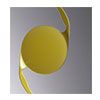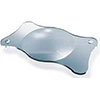What is Cataract?
Inside your eye is a lens, much like the lens of a camera. The lens helps the eye to adjust its focus continually for objects that are at different distances in order to see clearly.
For perfect vision, the lens should be clear so that light can pass through it and reach the retina. When the lens becomes cloudy or opaque, light cannot pass through it and the vision becomes dim or blurred. A cloudy lens is called a cataract. Cataract is the most common cause of visual impairment and blindness in the world.
| • blurred vision |
| • double vision |
| • sensitivity to light |
| • the need for more light while reading |
| • night glares and halos |
| • reduced vision in the night |
| • changed prescription power for glasses |
Causes of Cataract
| • | The most common cause of cataract is the deterioration of the normal structure within the lens of the eye with age. Senile cataract can be compared to getting wrinkles and the hair turning grey. |
| • | There may be other causes like diabetes, kidney disease, glaucoma, smoking, eye injuries, infection, and inflammation inside the eye. Prolonged use of certain medications can also lead to cataract formation. A cataract may develop slowly over several years or rapidly within months. Often the other eye will also be affected, but it may not happen at the same time. There are no medications, eye drops, or dietary restrictions that can cure or prevent cataract formation. If the cataract interferes with your regular activities, the only solution is surgery. In cataract surgery your natural clouded lens is replaced by an artificial intraocular lens (IOL), which helps incoming light rays to be focused properly. Your new lens should restore vision to nearly what it was earlier, though you may need to wear glasses for reading or driving. |
When to Consider Cataract Surgery?
Time for cataract surgery depends on many factors including your quality of life, your occupational needs, personal health, grading of cataract, associated complications (if any), etc. and not for the cataract to mature fully or the vision to become totally cloudy.
For the most part, patients interested in surgery should ask their doctors about it sooner rather than later.
How are cataracts treated?
Surgery is the only treatment for cataract. An eye surgeon will remove your cloudy lens and replace it with a clear, man-made focusing lens (intraocular lens implant, or IOL). The replacement lens implant remains permanently inside your eye and does not degrade.
Cataract surgery is usually a day care procedure, which means that you will go home on the day of your operation.
Planning For Surgery
At the Hospital, we will help you to understand the pre-operative procedures and obtain an estimate of the expenditure involved. Prior to your surgery, you will need to undergo some routine medical and blood tests. An A-scan will help the doctor to determine the power of the artificial lens to be implanted in your eye.
It is good to wash your face thoroughly with soap and water before coming for surgery. You will be advised to use some eye drops prior to the surgery.
Surgical Techniques
Several techniques are used for removing cataracts.
The procedure has a 98% success rate.
Phacoemulsification: In this method a tiny instrument is inserted through a very small incision. The instrument uses ultrasound vibrations to break the cataract into fine pieces, which are gently suctioned out. The new lens is then inserted into the eye. Usually no stitches are required to close the incision. This minimal surgery allows faster and safer healing, hastening your return to normal activity. A cataract operation lasts approximately 15 – 30 minutes, depending on the complexity of the case.
Technology at Aggarwal Eye Hospital: The Infiniti Vision System with the OZil® Torsional hand-piece phaco device has unique features like side-to-side oscillating ultrasonic movement. It emulsifies the lens material from both the directions with its side-to-side movement, increasing its cutting efficiency. The dynamically adaptive software of OZil® Intelligent Phaco continuously monitors and responds to the ongoing phacoemulsification conditions throughout the procedure for more effective energy delivery, minimizing trauma to the ocular structure and optimizing post-operative outcomes.
Benefits of Phaco surgery?| • Return home within hours of the procedures without bandage. |
| • Fast recovery of good vision in a matter of days instead of weeks or even months. |
| • Minimal restriction on activities i.e. normal household, recreational and even occupational activities may be resumed within a day or two. |
| • No bandage, no dark glasses, no restrictions and no precautions. |
| • Final spectacles at two weeks, Immediate provision of temporary reading glasses if desired. |
| • No wound or suture related complications. |
| • Yields a stronger eye resistant to injuries. |
| • Less inflammation after the surgery. |
Small Incision Cataract Surgery (SICS): This is a new technique where the cataract is removed manually through a small incision. The small incision heals fast, enabling you to recover quickly.
Extracapsular Extraction: Here the lens is removed in a single piece through a relatively larger incision. It is replaced with an artificial lens and the incision is closed with fine stitches. The surgeon may opt for this technique in cases where the cataract is very advanced. The recovery period is longer here.
Your doctor will select the method of surgery that is most suitable for your case.
AFTER CATARACT SURGERY CARE
You should wear protective glasses in the day. The doctor will advise you when you can discontinue them. You can bathe carefully from below your neck but do not wet the operated eye for 15 days. You may gently clean the eyelids with a piece of cotton boiled in water or a sterilized tissue.
Please follow the advice of the doctor about medication and follow-up visits.
| • Any sudden change in vision or blurring of vision |
| • Increase in redness |
| • Swelling of the eyelid or bleeding |
| • Nausea or vomiting |
| • White or cloudy cornea |
| • Persistent discomfort or pain - if the pain is severe, do not delay, contact us immediately. |
Secondary Cataract
Blurred vision, months or years after cataract surgery, leads to the mistaken assumption that the cataract has grown again. This is not a cataract but the clouding of the thin capsular bag membrane that helps keep the lens implant in place.
To restore clear vision surgeons use a laser to open a visual path through the cloudy membrane. This is a simple procedure and is done on an outpatient basis. No stitches or surgery are needed. Your vision should improve soon after the laser treatment.
FAQs
Q. Can I have non-surgical methods of treating cataract?
A. NO. At present only surgical correction is the solution to treat cataract.
Q. Are Both Eyes Operated on the Same Day?
A. No, only one eye is operated at a time, due to the potential risk of infection.
Q. Is the surgery carried out under local anaesthesia?
A. YES. 99.9 % cases are performed under local or topical anaesthesia. Rare cases may require general anaesthesia.
Q. What are the risks involved in undergoing cataract surgery?
A. The potential risks associated with cataract surgery are very, very rare. However, they include infection, glaucoma, retinal detachment, capsule tear and vitreous displacement, wound dehiscence and iris prolapse, cystoid macular oedema, deterioration in diabetic retinopathy, haemorrhage, dislocation of the intraocular lens and lens implant power miscalculation. Some patients may require further surgery following cataract surgery.
Q. Will I require any eye medication following surgery?
A. Yes. Few medications will be started following your cataract surgery which will fasten up healing and recovery. It is very essential that you instill these medications as per the doctor’s advice and never miss a dose.
Q. What must I avoid following surgery?
A. Avoid touching or rubbing the operated eye. No head bath or face wash for at least 15 days.
Q. When will I be able to see clearly after cataract surgery?
A. Most patients see good within a day or two after cataract surgery. Few patients may see blur in the initial 1-2 weeks due to slower healing responses which improves over a period of few weeks.
Q. Will I need glasses following surgery?
A. You may require glasses following a cataract surgery depending on your pre-operative refractive status, type of lens implantation and healing response of your eye. After about 3 weeks of surgery, you will be provided with glasses (if required)
Q. Is my cataract surgery covered under insurance?
A. YES.
What type of intraocular lenses (IOLs) are available?
At Aggarwal Eye Hospital, we offer a wide array of intraocular lenses (IOLs) to suit every patient’s individual needs.
o Aspheric Monofocal IOLs: These are standard IOLs implanted in the eye after cataract surgery for correction of distance vision only and offers improved contrast and night vision. Patients will require glasses for near vision and computer use.
These are standard IOLs implanted in the eye after cataract surgery for correction of distance vision only and offers improved contrast and night vision. Patients will require glasses for near vision and computer use.
 These IOLs filters both UV and high energy blue light. Blue light which may cause retinal damage and play a role in the onset of age-related macular degeneration is filtered out.
These IOLs filters both UV and high energy blue light. Blue light which may cause retinal damage and play a role in the onset of age-related macular degeneration is filtered out.
 Astigmatism is caused by the cornea being more curved in one direction than the other, much like a football. Toric IOLs are specially shaped IOLs designed to offset the imbalance created by the irregular shape of the cornea. Once implanted and aligned inside the eye, they stay fixed in place thereby eliminating pre-existing astigmatism.
Astigmatism is caused by the cornea being more curved in one direction than the other, much like a football. Toric IOLs are specially shaped IOLs designed to offset the imbalance created by the irregular shape of the cornea. Once implanted and aligned inside the eye, they stay fixed in place thereby eliminating pre-existing astigmatism.
 For most cataract patients, life without reading glasses or bifocals is something they either experienced before presbyopia or they just dreamed about for most of their lives. But today, the Multifocal IOL is turning those dreams into reality with its revolutionary lens technology that can provide patients a full range of vision -- near through distance -- and greatly reduce their reliance on reading glasses or bifocals.
For most cataract patients, life without reading glasses or bifocals is something they either experienced before presbyopia or they just dreamed about for most of their lives. But today, the Multifocal IOL is turning those dreams into reality with its revolutionary lens technology that can provide patients a full range of vision -- near through distance -- and greatly reduce their reliance on reading glasses or bifocals.
 As the name suggests, these Toric IOLs are implanted in patients with pre-existing astigmatism and cataract. They provide spectacle-free vision at all ranges of work, distance, near and intermediate.
As the name suggests, these Toric IOLs are implanted in patients with pre-existing astigmatism and cataract. They provide spectacle-free vision at all ranges of work, distance, near and intermediate.
© Aggarwal Eye Hospital |
Site designed by Rainbow Web |